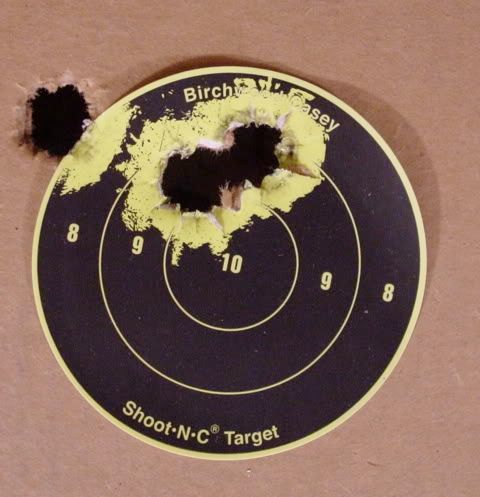Dan:
Nice group!
If I understand it correctly, your argument at its base seems to be that the roundball is superior in most, if not all, categories to a conical of any design: flatter trajectory, more dependable penetration, etc.
As we both know, the relative merits of both projectiles have been the subject of discussion and debate, not to mention flat-out, red-in-the-face arguing, for probably 150 years or so. And, although I prefer the minie, I don't have a particularly large dog in that fight. To each his own, says I.
My dispute is with your characterization of the minie as "nearly useless." As I said above, here in the East and Midwest, where many if not most whitetails are taken at less than 75 yards, that rainbow trajectory to which you refer is not nearly so pronounced.
It is, in fact negligible -- as is the concern you raise of the minie being "always" prone to sliding away from the powder. Well, yes, I suppose that can and maybe does happen, but it as been heavily discounted on this board and among those I know who hunt with, and periodically check the seating of, minies. Many mishaps can happen. Fortunately, when minies are properly sized and lubed, few do.
The problem with the whole of your argument, as I see it, is that despite the advantages you argue, the conical supplanted the roundball in black powder cartridge arms shortly after the shooting stopped in 1865. And while I realize full well this is a muzzleloading board, the word "cartridge" plays into another of your statements.
No, the minie did not become the projectile of choice in the civilian world, but there are several arguable reasons for that.
The minie was transitional technology. For one, the bullet style (more properly the "Burton" ball, after its American tweaker) was adopted less than a decade before the Civil War, in a time when the trendiness of today, pushed by a dozen gun magazines, had not taken its expensive toll on the largely poor shooting public. For another, during the war, production was consumed in both nations by military use. For a third, the development of cartridge arms during the conflict meant the minie, and the fine rifles that used it so effectively, were obsolescent by 1865. Those who wanted rifles went to Winchesters, Ballards, Henrys, Maynards and Sharps cartridge guns. That's why countless fine Springfields and Enfields were bought up and bored out for shotguns. Sodbusters and other pioneers found a shotgun far more practical than a rifle, no matter the shape of any bullet.
So the minie became, in effect, the "video" or "8-track" tape of its day -- an excellent improvement that, due to American inventiveness, had a relatively brief shelf life.
And one last point of fact in this overlong post: At no time did I state, as you apparently misread, "that the Minie was easier to cast than a ball." What I said was, "ease of loading and casting." As Casey Stengal said, "You could look it up."
When I cast my annual supply of black powder projectiles, I place side-by-side on my bench my Lyman roundball and minie moulds along with my Rapine Sharps mould. When the bottom-pour RCBS furnace and moulds are hot, it's one-after-the-other-after-the-other for about 300 projectiles an evening, pausing occasionally to reload and stretch. Fewer than a half-dozen rejects per mould per session. I'd have to say that constitutes "ease of casting" for a projectile that is far from useless.
:v :thumbsup:







